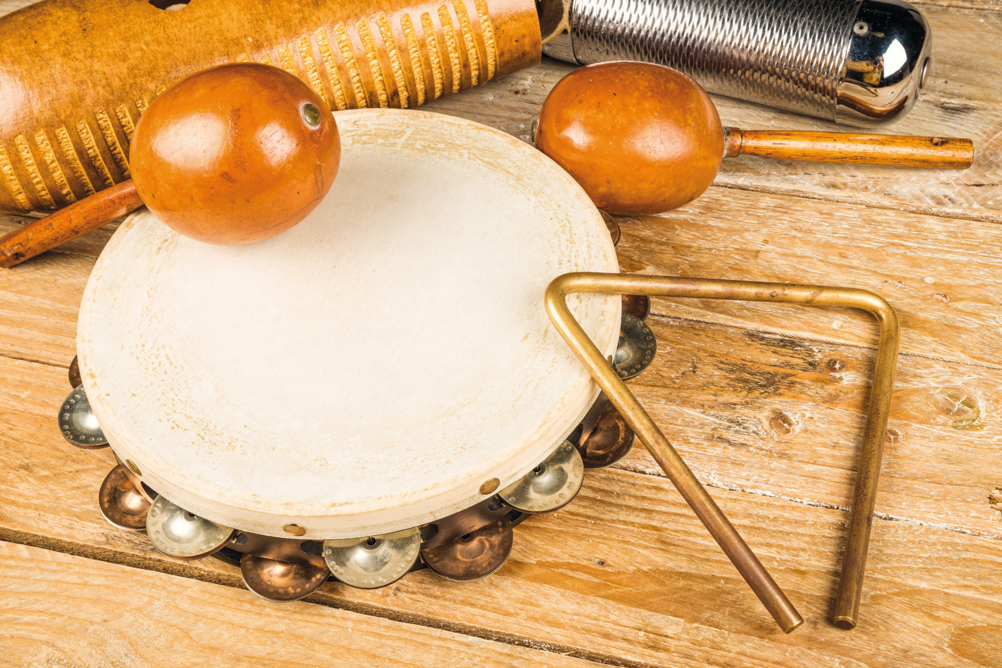
How do you teach rhythm to early years or kindergarten children? Ideally, children need to identify each type of percussion instrument and sound. They should distinguish between wood, metal and skin, and between ‘by hand’ and ‘with sticks’, or shaken, struck, plucked, tapped and blown! They should also be able to recognise key elements of music, including high and low (pitch), long and short (duration), loud and soft (dynamics), and fast and slow (tempo), while becoming familiar with a wide range of musical styles from around the world.
As a trained percussionist, while introducing each of the main classroom instruments, I like to demonstrate the correct way to hold and play the instruments, and how to create a wide variety of sounds. For reference, there are plenty of examples on YouTube of best practice.
With a view to playing a simple rhythm on each instrument in turn, I like to start with the bongos. My group is usually sat in a circle, with good lines of vision.
First, play a simple rhythm such as one crotchet beat on the low bongo followed by a beat's rest and then two beats on the high drum. Use right and left hands, and repeat the phrase:
- Low (rest) high high, Low (rest) high high etc.
R - L L R - L L
Then ask the young learners questions about what you have just played. Are the bongos made from wood or metal? Do they have a skin? Did I play loud or soft? … long or short sounds? … with hands or sticks? … a high or low sound, or both?
Now pass the bongos round the circle, asking each child to play the same Low-(rest)-high-high rhythm. After the children have experienced playing, you can demonstrate a rhythm for them to listen to, from an area in the world in which the instrument is typically heard. So, for instance, on the bongos I play a rumba from Cuba:

Extension
This method can now be applied to other instruments:
Agogo bells. Point out the difference between high and low sounds, using the pattern High high low (rest), High high low (rest). Then demonstrate a samba pattern on the agogos. There's a video on how to play these here.
Claves. Show how to hold the claves correctly (there's a useful video for this here) to produce the high pitched ‘click’. Then perform the following rhythm:
- (Rest) (rest) click click, (Rest) (rest) click click
You can now demonstrate a traditional 3/2 bossa nova clave rhythm.
Guiro. Play two short beats by tapping the stick on the guiro, and a long note, for two counts, by scraping along the ridges:
- Short short L…o…n…g, Short short L…o…n…g
Tap tap Scrape, Tap tap Scrape
Now, consider playing a Puerto Rican salsa!
Tambourine. Shake the tambourine for a long note (two beats) with a loud sound, then tap the head of the tambourine softly for two short beats:
- Shake… Tap tap, Shake… Tap tap
Now play an example of a Spanish bolero.
Triangle. Explain how best to hold a triangle and where to strike it to produce the sweetest sound (top corner, opposite the gap). I like to demonstrate one long sound for two beats, letting the triangle ring through, followed by two short beats played with a dampened sound – by holding on to the triangle with the other hand. In other words:
- L…o…n…g short short, L…o…n…g short short
After the children have experienced playing the triangle, play them a beguine from Martinique.
Maracas. Demonstrate the difference between long and short notes, ‘tapping’ the maracas for two short beats then shaking them for two, for a longer sustained sound:
- Short short L…o…n…g, Short short L…o…n…g
Now play the group a Mexican mariachi rhythm. With this (and the examples above), try to point out the elements discussed.
To finish on a high, I like to end the session with the whole class playing together as an ensemble, using the rhythms and playing techniques they have learned during the lesson.




